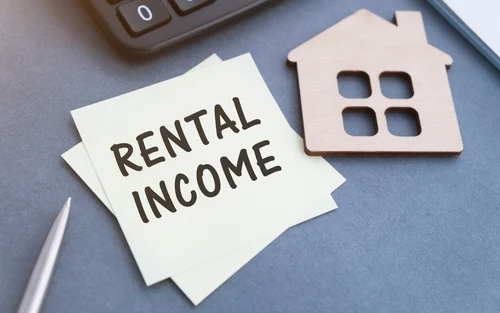Are Mortgage Payments On a Rental Property Tax Deductible?
Best Mortgage Lenders for Investment Property Mortgages (including non-QM)
September 29, 2022Can you Deduct Mortgage Interest on Investment Property?
September 30, 2022Not quite. While the principal component of your mortgage payment for an investment property is not deductible, the interest that accrues on top of the loan is. Any costs associated with your mortgages, such as account and maintenance fees, are also tax deductible. It is comforting knowing tax deductions would offset the interest, which is a major long-term burden. Let’s look at an illustration: If you borrowed $500,000 for a property over 25 years at a 2.9% interest rate, your interest payments would be about $200,000.
Although the interest is tax deductible, it is not “free money” if you intend to keep the home as a rental for the duration of the loan. Always work to get the lowest interest rate, considering any fees and how well the loan fits into your lifestyle. If you had a rate of 2.5% in the prior case, you would have paid roughly $30,000 less in interest overall.
The owner deducts the expenses associated with owning, operating, and maintaining a rental property. In addition, taxes on your rental property may be reduced by hundreds of dollars over time, thanks to mortgage-related deductions. The federal government offers these tax advantages to reduce the costs of the real estate industry. In order to increase your wealth as a landlord, you can use the tax savings back into marketing, improvements, and even the purchase of more rental properties. Renters can then benefit from lower property costs, boosting housing demand and stimulating the economy.

What Deductions Can I Claim for My Rental Property?
You can use deductions as a landlord to offset rental revenue and pay less in taxes. For example, you can generally write off qualified operation expenses, repair charges, and qualified rental expenses (such as mortgage interest, property taxes, interest, and utilities).
The cost of purchasing and upgrading the property can also be written off throughout its “useful life,” typically 27.5 years. Additionally, you could be able to deduct 20% more of your eligible company income (QBI). The rental property must, among other requirements, “raise to the level of a trade or business under section 162” of the Internal Revenue Code to qualify for the QBI deduction.
Divisions of your Monthly Mortgage Statement
Your monthly mortgage statement comprises your escrow account deposits and principal and interest payments. Since principal payments decrease your mortgage loan balance and increase your home’s value, they are not considered costs. The difference between the value of your home and the amount owed on your mortgage encapsulates ownership.
Property tax and private mortgage insurance (PMI) responsibilities are paid for via escrow account deposits that your lender collects on your behalf. Therefore, you can deduct property taxes and PMI from your rental property revenue. Tax credits should not be confused with tax deductions. Since they reduce your tax liability dollar for dollar, tax credits offer direct tax relief. Tax deductions decrease your taxable income. You then determine your overall tax obligation.
But first, think about the kind of investor you are in real estate. Are you a real estate expert or a passive investor? Your income and losses are handled differently depending on whether you fall under one category.
Most people perceive real estate to be a passive activity. However, the tax treatment of the property’s income and losses depends on your participation level. Let’s examine some of the various categories of participation levels you can fall into.
Real estate professionals
A real estate professional is someone who devotes more than half of their working time to the rental industry, according to the Internal Revenue Service (IRS). To be considered a professional, you must work on your real estate rental properties for more than 750 hours annually. This could involve managing, building, and developing real estate.
Real estate professionals’ activities are not regarded as passive. Instead, the money you make is “active income” (i.e., non-passive income). As a result, if the rental generates revenue, you can use losses to offset other income (such as wages, salaries, interest, and dividends) and evade the 3.8% net investment tax.
Material participation
Your involvement with rental properties will earn non-passive tax treatment if you meaningfully contributed as a real estate professional. You won’t be liable to the net investment tax and can use any losses to reduce other forms of income.
The IRS claims that if you meet any of the following criteria, you materially participated in an activity:
- Over the course of the year, you engaged in the activity for more than 500 hours.
- You perform all the work in the activity or virtually all of it.
- Over the course of the year, you put in at least as many hours (100+) as everyone else in the activity.
- You spent at least 500 hours participating in this significant participation activity (SPA), which is what it is.
- For any five of the previous ten years, you materially engaged in the activity (whether consecutive or not).
- You materially participated in the activity for three prior tax years, which is a personal service activity.
- You engaged in the activity “regularly, continuously, and substantially” during the year, considering all the relevant facts and circumstances.
Active participation
Active participation is a lesser level of involvement when compared to material participation. If you make managerial choices in a meaningful and bona fide sense, the IRS will consider you as someone who is actively engaging. Active participation in management decisions includes activities like:
- Approving new tenants
- Determining rental terms
- Approving expenditures
Some of your passive losses may be deductible if you actively engage by making management choices and own at least 10% of the investment. This level of involvement enables a unique passive loss rule. Generally speaking, if your modified adjusted gross income (MAGI) is $100,000 or less, you are eligible to deduct up to $25,000 in passive losses. Suppose your MAGI is between $100,000 and $150,000, the deduction phases away. You cannot take any passive losses if your MAGI reaches $150,000. Losses exceeding $25,000 are allowable for carryover to the following year.
Passive activity
On the other hand, your rental property is considered a passive activity if it is a sideline investment in which you do not materially participate. Any losses from a passive activity in this situation may only be used to reduce passive activity income. In other words, any losses from the rental property cannot be used to offset other taxable income. Instead, the losses are held over until you sell the investment or create passive income.

Rental Property Income Sources
If you own rental property, you must declare every rental revenue source, including not just the regular monthly rent payments. Let’s examine some common rental income sources:
Rent
Rent payments are often taxable in the year they are made rather than when they were due or earned. Any advance payments must, therefore, also be considered income.
Consider renting a home for $1,000 per month and requiring new renters to pay the first and last months’ rent upfront. In this situation, even though $1,000 of the $2,000 you received covers a period that could be several years in the future, you must still disclose the $2,000 you received as income.
Tenant-paid expenses
If your tenants pay a cost they are not required to, the cost counts as rental income. Let’s say, for instance, that your tenant pays the water bill and subtracts it from the regular rent payment. If so, the sum must be included in your rental income. Depending on the expense, you may then write off the cost as a rental expenditure.
Trade for services
You must include the fair market value of the tenant’s services as income if they offer to trade them for rent. So, for instance, even if you didn’t receive the $1,000 cash, you must report it as income if your tenant paints the rental home in exchange for one month’s rent ($1,000). The $1,000 can be written off as a cost, though.
Security deposits
If your goal is to return the money to the tenant at the end of the lease, security deposits are not taxed when you receive them. But what if your tenant violates the conditions of the lease? As an illustration, let’s say you receive a $500 security deposit from your tenant, who then vacates the property and causes $500 in damage to the walls. The $500 must be declared as income for that year (but you can also deduct the repair costs).
It should be noted that a security deposit utilized as the last installment of rent counts as advance rent. So, the year you receive it, you must count it as income.
Rental Property Tax Deductions
Being a landlord is a lot of effort, but it can considerably increase your savings. You must find renters, obtain insurance, and pay a mortgage and property taxes in addition to handling the money and obligations associated with your living space. Your tax position may get more complicated if you rent a home. Fortunately, the government lets you write off part of the costs of managing a rental property. The IRS mandates that deductible expenses must be common, customary, and essential for managing and maintaining the property in the rental business.
To handle the tax and economic effects of your real estate holdings, you can also work with a financial advisor at Aurum and Sharpe. You can write off various costs associated with purchasing, running, and maintaining a rental property. A list of the most frequent deductions is explained below:
Mortgage interest deduction
Mortgage interest is deductible as a business expense for assets used as investments. Mortgage application fees, commissions, and appraisal fees are not tax deductible at the time of payment. Instead, your basis in the property is increased by these expenses. On your first or second home, you can still deduct interest on up to $750,000 ($1 million if you took out the mortgage before December 16, 2017) of secured mortgage debt.
Mortgage interest for residential properties is recorded on Schedule A of the 1040 or 1040-SR tax form, but mortgage interest for rental properties is reported on Schedule. Every year, your mortgage company will issue you an IRS Form 1098 that details how much interest you’ve paid over the course of the year. Your mortgage company should also inform you if a portion of your payment goes into an escrow account to pay taxes and insurance.
The maximum mortgage principal eligible for the deductible interest for new loans was cut to $750,000 (from $1 million) by the Tax Cuts and Jobs Act (TCJA), passed in 2017. Additionally, the standard deduction was roughly increased by the TCJA, which discouraged many taxpayers from itemizing.
Rental property depreciation
The allowance for depreciation is another significant tax break. Depreciation allows you to spread out the costs of purchasing (or improving) property throughout the asset’s useful life. If a rental property satisfies these criteria, the IRS permits you to depreciate it:
- The property is yours.
- You utilize the property in your business or other endeavors that generate cash.
- The asset has a predetermined useful life, which means it will eventually wear out, deteriorate, be consumed, lose its usefulness, or depreciate due to natural occurrences.
- You anticipate that the asset will last for longer than a year.
- During the same year, the property was not put into operation and eventually disposed of (or stopped being utilized for business purposes).
Land is not depreciable since it is never used up. In addition, as clearing, planting, and landscaping charges are seen as part of the cost of the land, not the structures, you often cannot deduct them.
The IRS defines a rental property’s “useful life” as 27.5 years, which is how this method amortizes costs (and depreciation deductions) over that time. The Modified Accelerated Cost Recovery System calculates the depreciation on the residential rental property put into service after 1986. (MACRS).
Depreciation may save you money today, but the IRS may demand a portion of that savings. Depreciation recapture taxes are due on the gain if you depreciate property and sell it for more than its depreciated worth. Many real estate investors use 1031 exchanges to postpone paying taxes, such as capital gains and depreciation recapture.
Repairs and improvements
Owners of rental properties can believe that anything they do on the property qualifies as a tax deduction. However, the IRS claims that this is untrue.
A repair maintains the condition of your rental property and is a deductible expense in the year you pay for it. Painting, mending a malfunctioning toilet, and changing a light switch are examples of repairs. However, upgrades increase the value of your property and are not tax deductible at the time of purchase. Instead, you depreciate the costs throughout your property’s useful life to recoup the cost of property improvements (and purchases). A new roof, patio, or garage are a few examples of improvements.
It would be best if you made repairs when they arise rather than wait until they grow and need renovations from a tax perspective.
Property taxes
For owners of rental properties, property taxes are a recurring burden. Property taxes, state and local income taxes, and sales taxes can all be written off by homeowners for a combined deduction of up to $10,000 ($5,000 if married filing separately). However, corporate operations are exempt from this restriction. Therefore, you might be able to write off the entire sum as a business expense, depending on your level of involvement with the property.
Travel expenses
You can deduct the cost of any trip you incur to collect rent or maintain your rental property. However, if your travel was intended to make improvements, you must claim that amount as the cost of the upgrade.
There are two methods for deducting travel costs: the normal mileage rate or the actual costs. IRS Publication 463 contains the most recent information regarding the prerequisites and current mileage allowance.
Other common expenses
Some other typical costs you can deduct, in addition to mortgage interest, maintenance, and depreciation, are:
- Utilities
- The cost of personal property (e.g., appliances and furniture) used in rental activity
- Insurance premiums
- Lawn care
- Losses from casualties (hurricane, earthquake, flood, etc.) or thefts
- Professional services (e.g., accountants, tax preparers, property managers, attorneys)
- Advertising
- Employees and independent contractors
- Home office expenses

Conclusion
One of the most important advantages of owning rental real estate and receiving recurring income and long-term equity growth is using rental property tax deductions to lower taxable net income. You can lower your overall tax burden by reducing expenses like yard upkeep, property repairs between tenants, and even the annual mortgage interest. Maintaining detailed records of every aspect of your business operations is crucial if you want to accurately claim reasonable expenses and amounts at the end of the tax year. The portions of the monthly mortgage payment utilized for mortgage interest, property taxes, and insurance are completely deductible expenses, even though the total mortgage payment of PITI is not.
When you think about the tax laws before getting started, you will find out that rental property ownership usually turns out to be the most profitable. Since numerous deductions are available, it helps to be aware of the ones you are entitled to optimize your income. Furthermore, you must comprehend how taxes apply to your rental revenue and the eventual sale of your property. You can speak with a certified tax professional at Aurum and Sharpe for more advice and assistance with deductions, taxes, and planning.
Mortgage Rates
DSCR Mortgage: 7.375%
Commercial Mortgage: 7.5%
Single family, Condo Investment Property: 7.375%
Portfolio of Residential Homes: 7.5%
Calculate Your Monthly Payment
Mortgage Information
Monthly Payment
Principal and Interest: $0
Total Monthly Payment: $0


